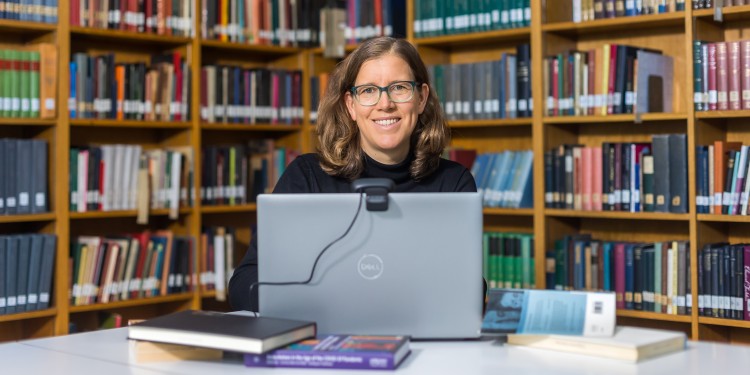
Upgrading a piece of furniture
Our world changed in the spring of 2020. We were living in lockdown, working from home. We kept our distance from our family, from friends, and from colleagues at work. We had to hunt down pasta, yeast and toilet paper in the supermarket. The COVID-19 pandemic placed considerable restrictions on our everyday lives and working practices. The platform Zoom became a byword for digital video conferences and meetings. And one piece of furniture acquired a new status as an indispensable prop for virtual meetings and media interviews – the home bookshelf. Dr. Corinna Norrick-Rühl, Professor of Book Studies at Münster University’s Department of English, is the co-editor of a collection entitled “Bookshelves in the Age of the COVID-19 Pandemic”, which examines the privileges of private book ownership. With a Swedish “Billy” bookshelf as the starting point, she and 14 other authors look at questions of participation in society.
“Books and a well-stocked bookshelf have always been status symbols,” says Norrick-Rühl. “Having a well-stocked bookshelf at home denotes authority, security and the feeling of having ‘arrived’ in a place,” she explains. “But when the pandemic arrived, the borders between spaces used for work and those used for private life were blurred. The way our houses were furnished, our families, our bookshelves – they all suddenly became visible.” Anyone was now able to stop online discussions which had been recorded and made public – in which well-known people were seen sitting in front of a bookshelf – and take a look at what book titles there were on display. “Anyone who enjoys reading wants to know what other people are reading. It is a natural curiosity, basically – like looking through windows into rooms where the lights are on when you go for a walk in the evening,” she adds. At the beginning of the pandemic, for example, an account called “Bookcase Credibility” was set up on Twitter. It currently has more than 115,000 followers, and short reviews of bookshelves seen in interviews in the media are still regularly posted on it today.
Public libraries were closed for a long time during the COVID-19 pandemic, and many institutions quickly thought about how readers could access books in spite of the lockdown regulations – for example, by ordering them with time-slots for collecting them, or by means of book-boxes. “Nevertheless,” says Norrick-Rühl, “during the pandemic a lot of people – in particular, children in families who had very few books, or none at all – missed out on books usually provided free of charge by kindergartens or school libraries. In contrast, families who had lots of books bought higher-than-average numbers of them, with purchases of books for children and young people enjoying a veritable boom.
Publication
Corinna Norrick-Rühl, Shafquat Towheed (Eds.): Bookshelves in the Age of the COVID-19 Pandemic. Berlin 2022. 297 pages, €139,09. ISBN: 978-3-031-05291-0.
Author: Kathrin Nolte
This article was first published in the University newspaper “wissen|leben” No. 7, 16 November 2022.
